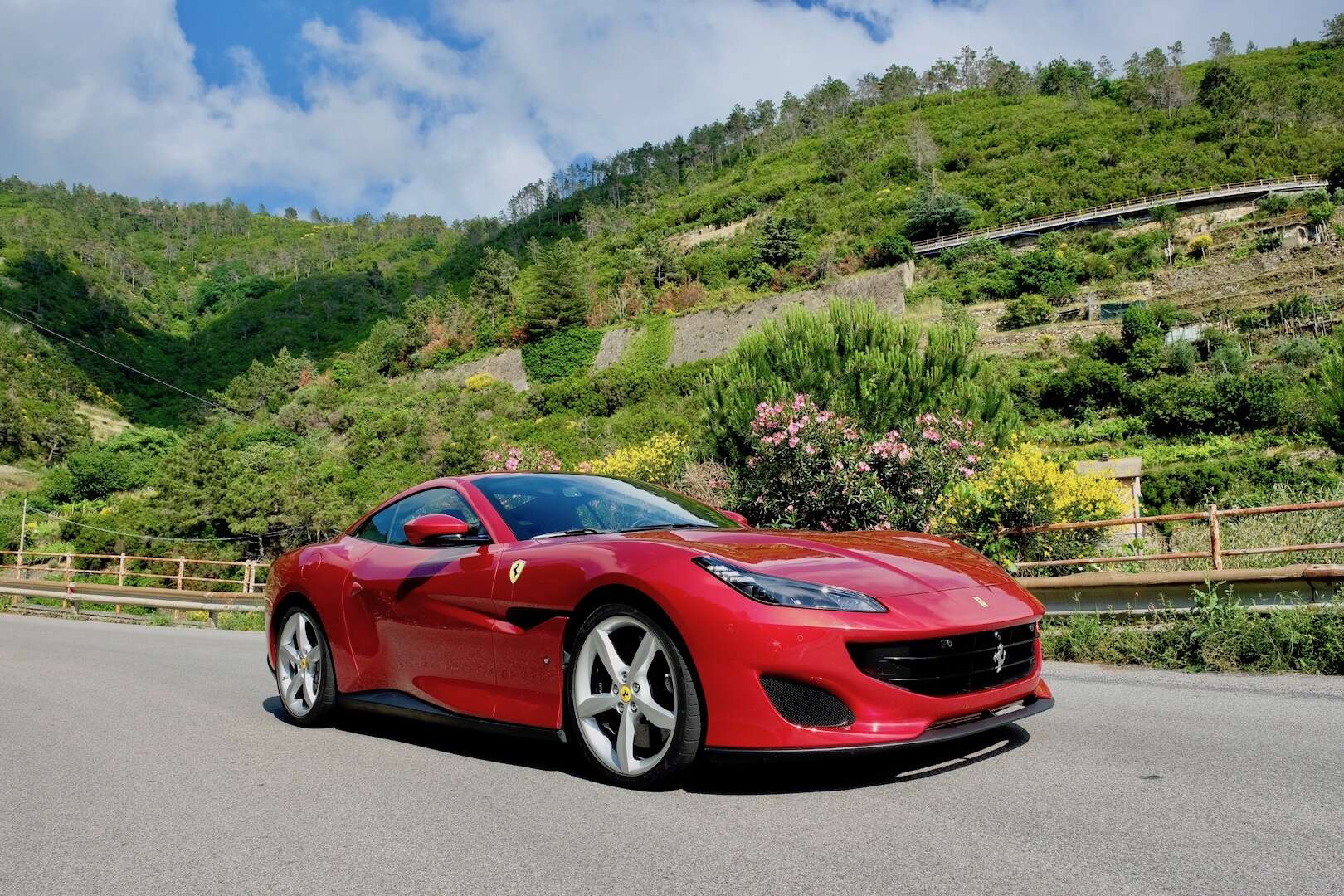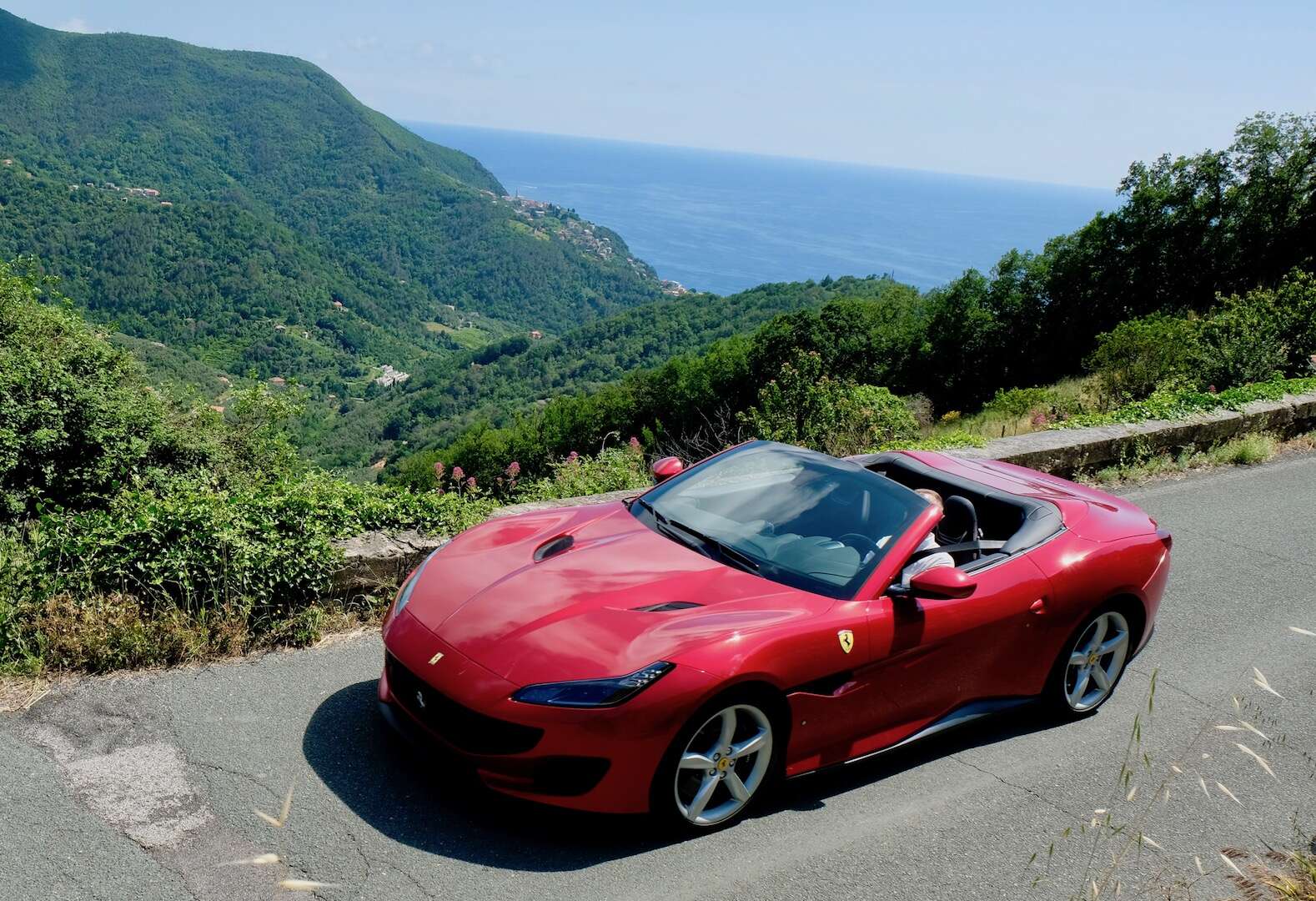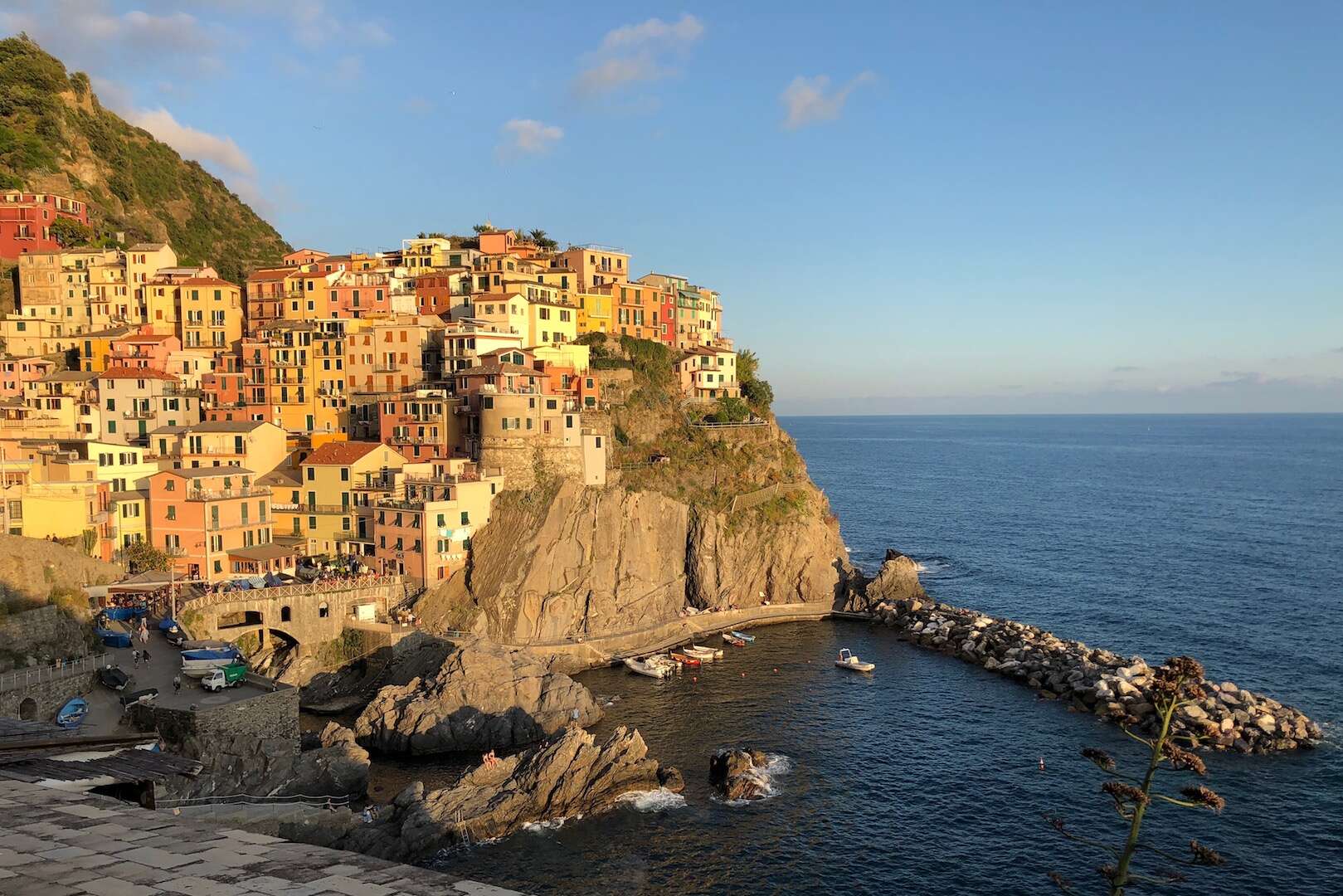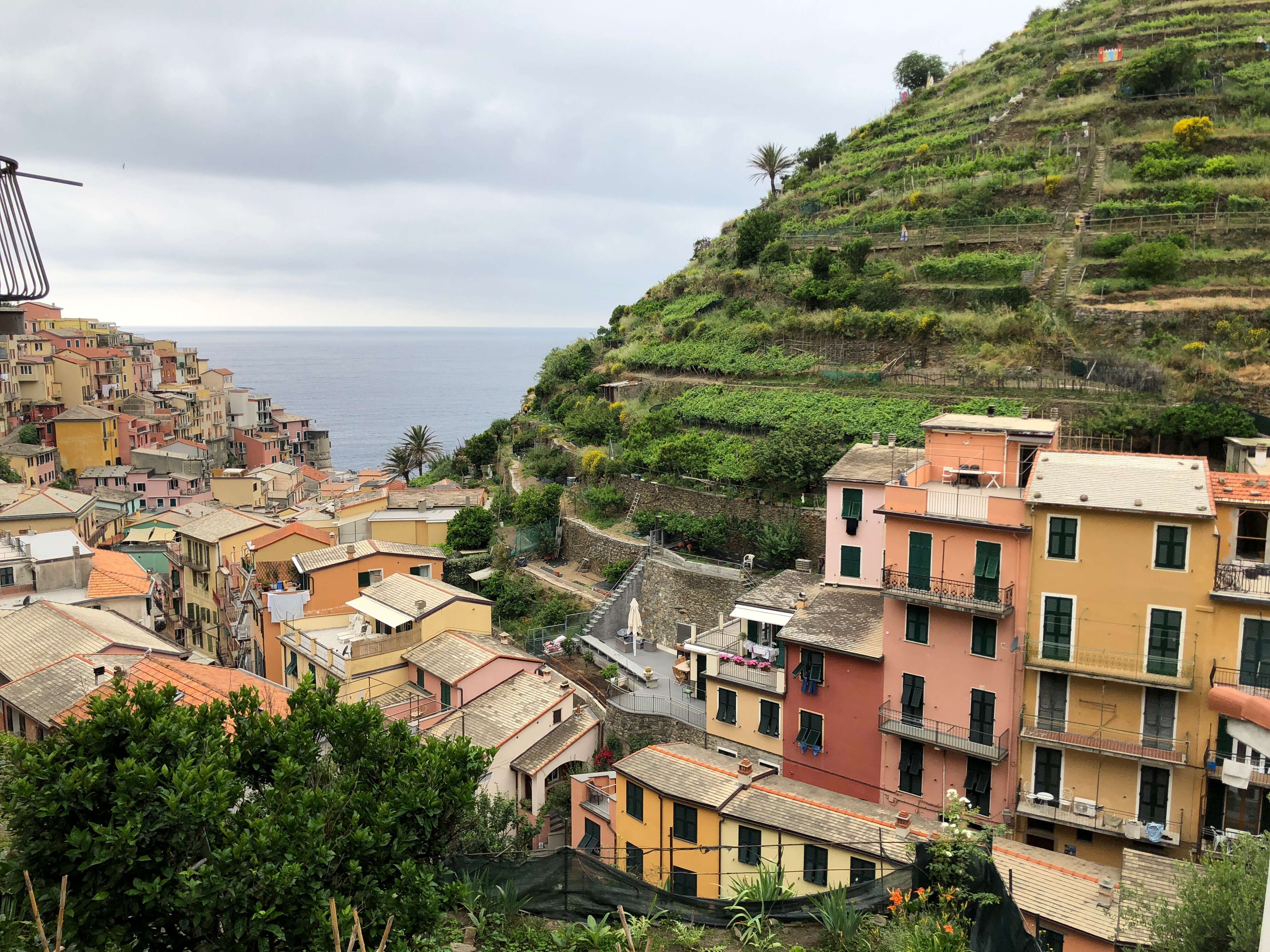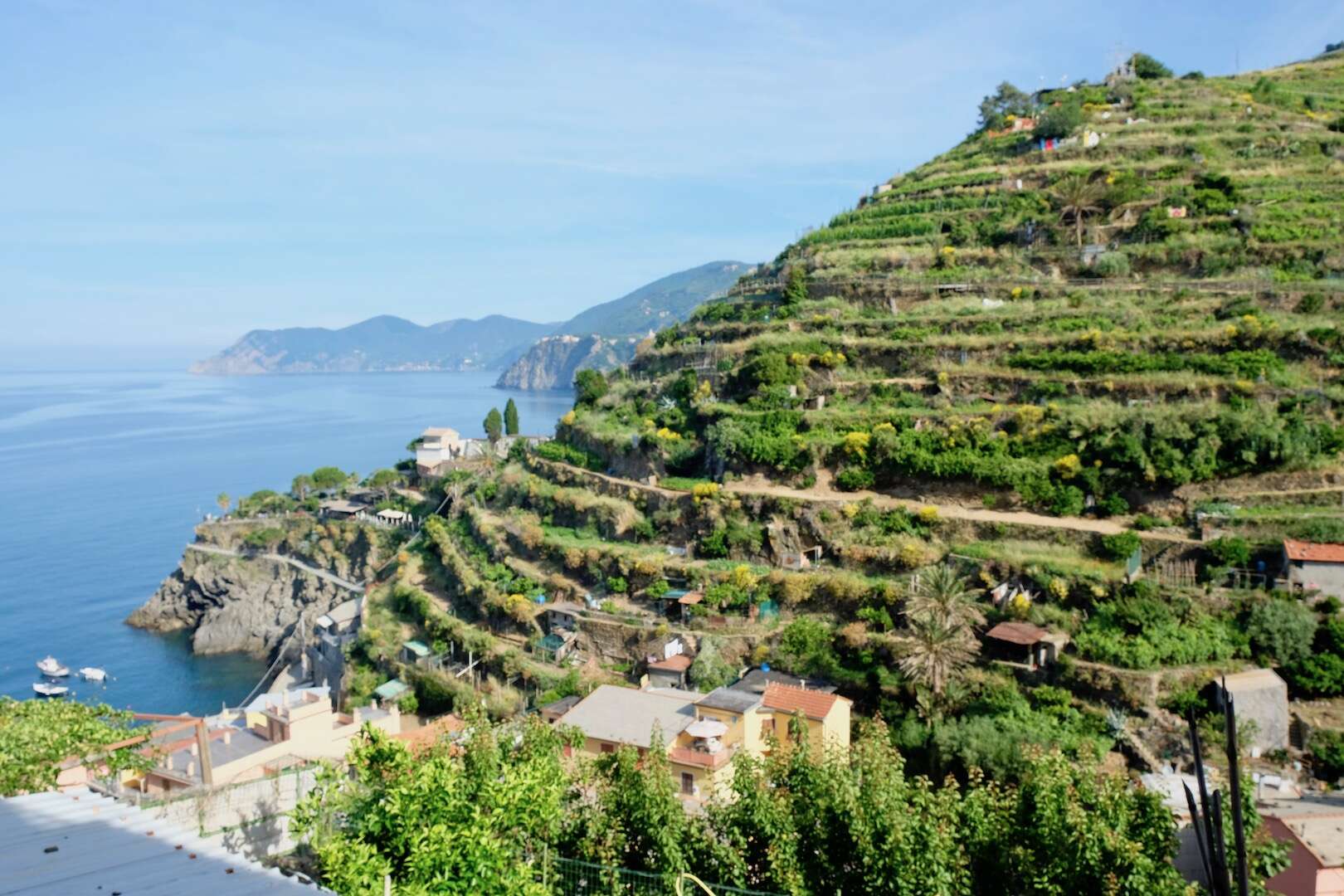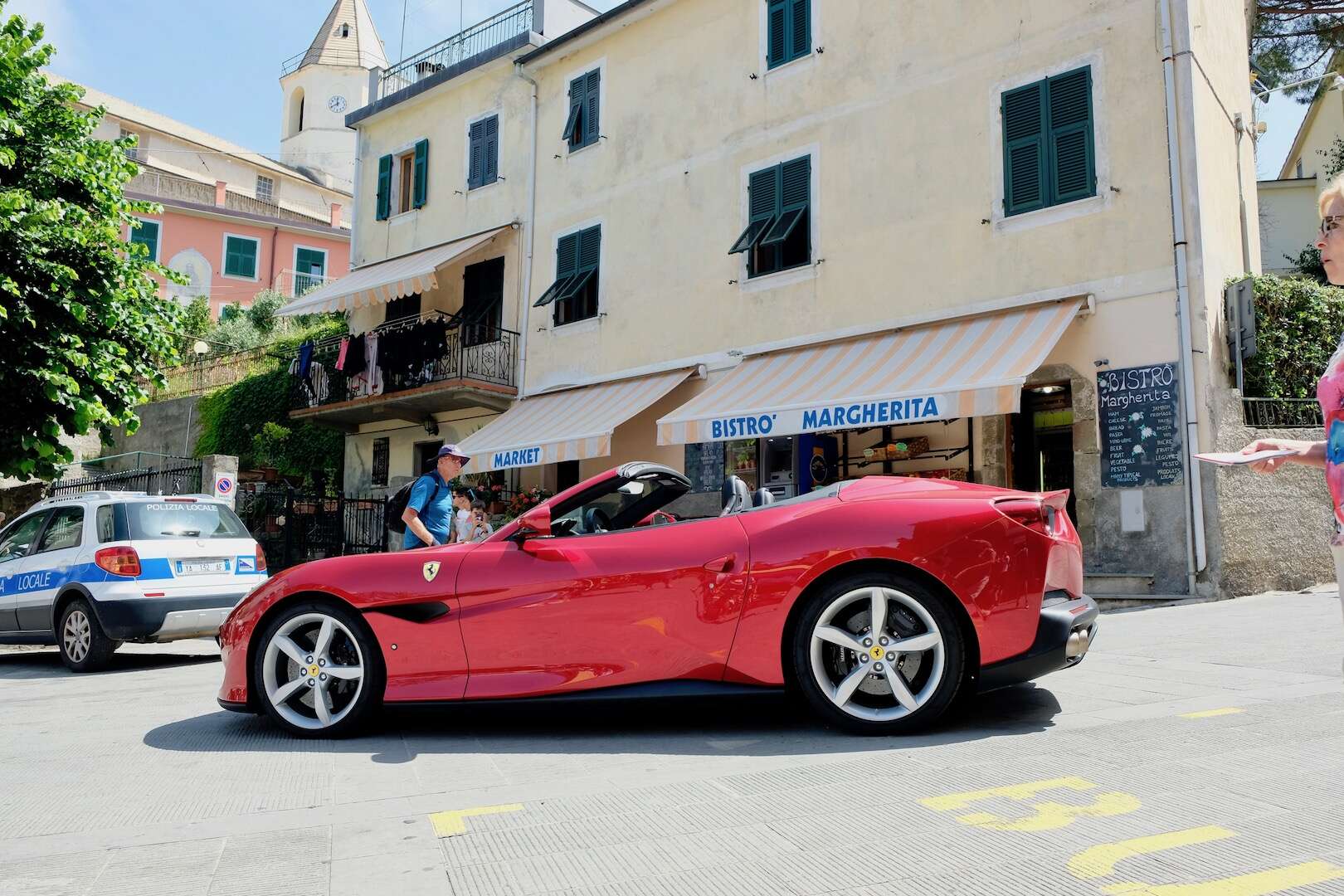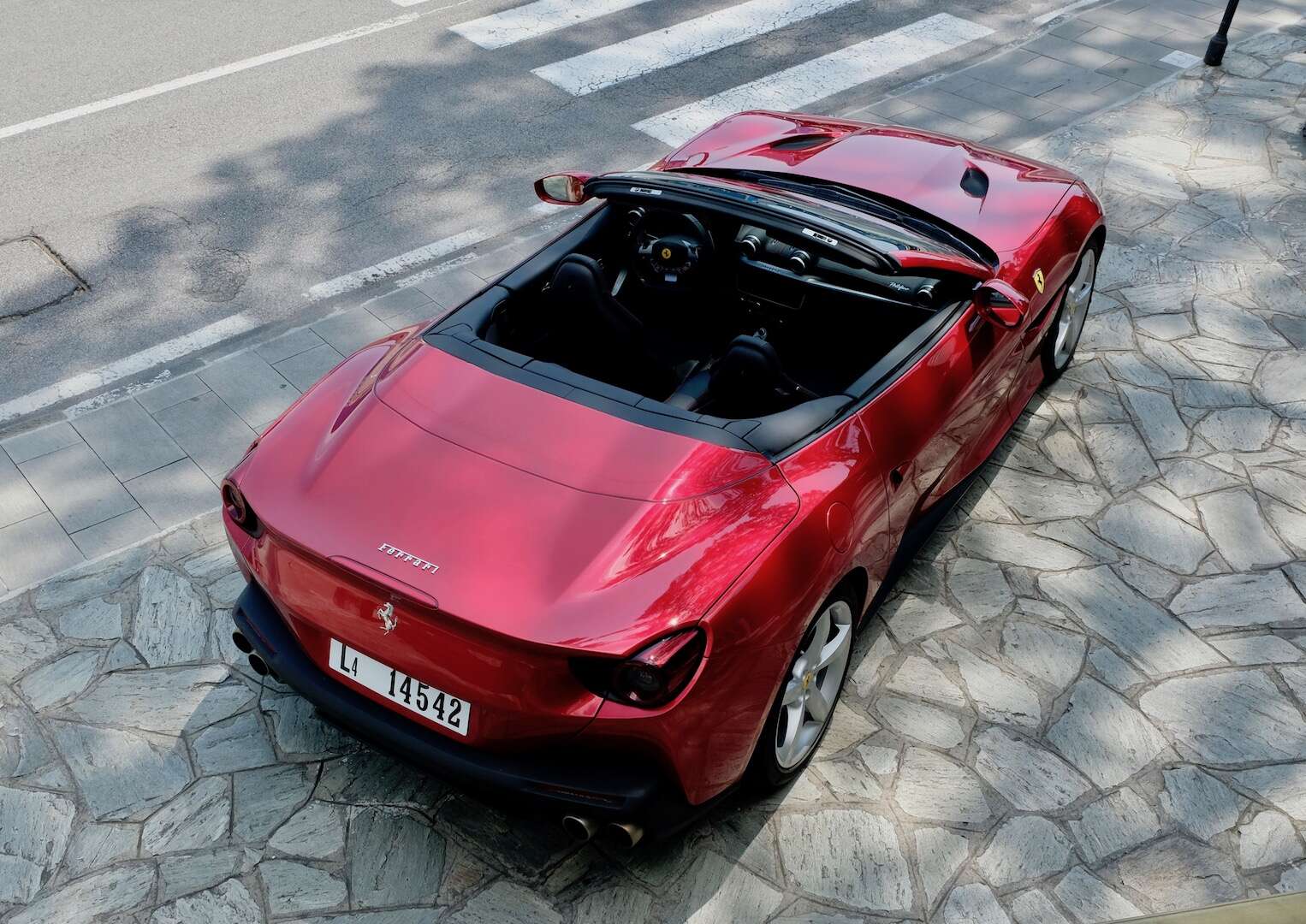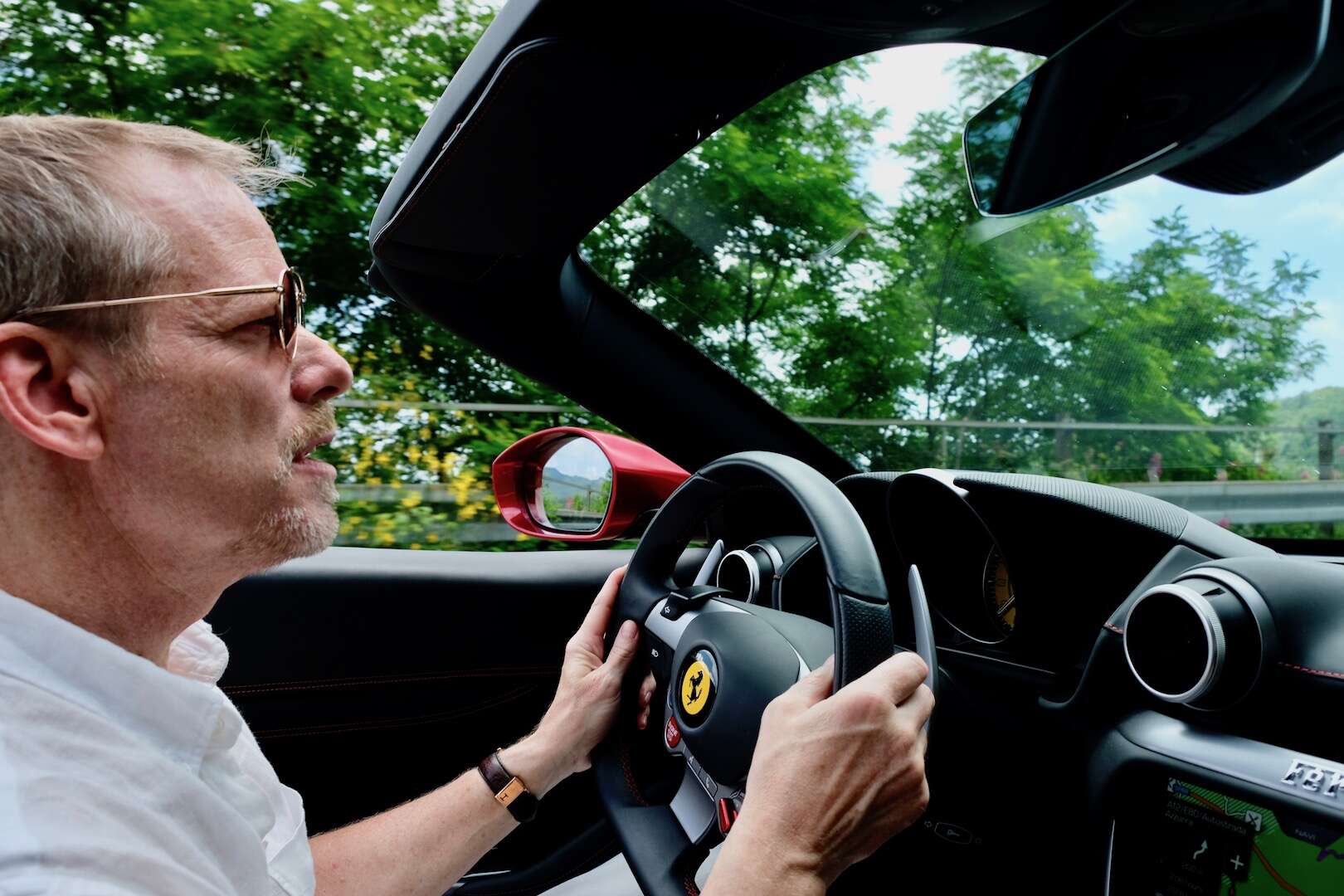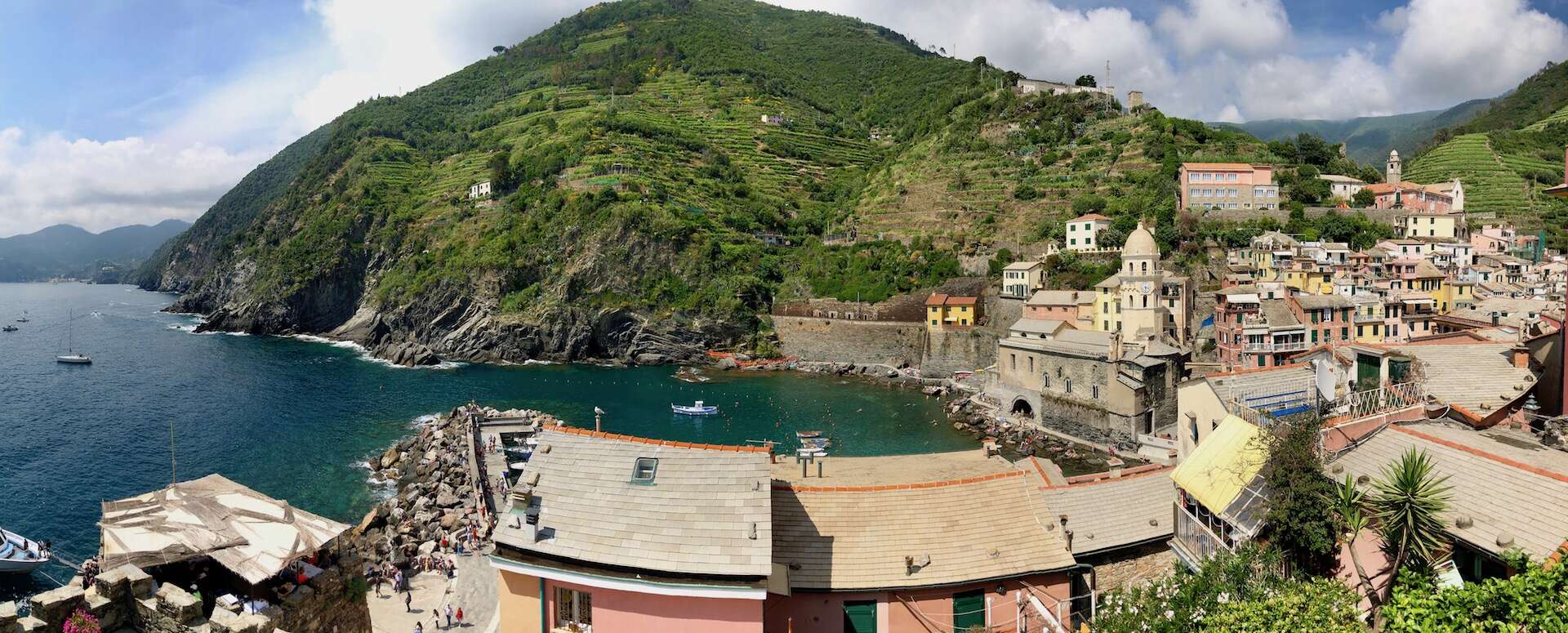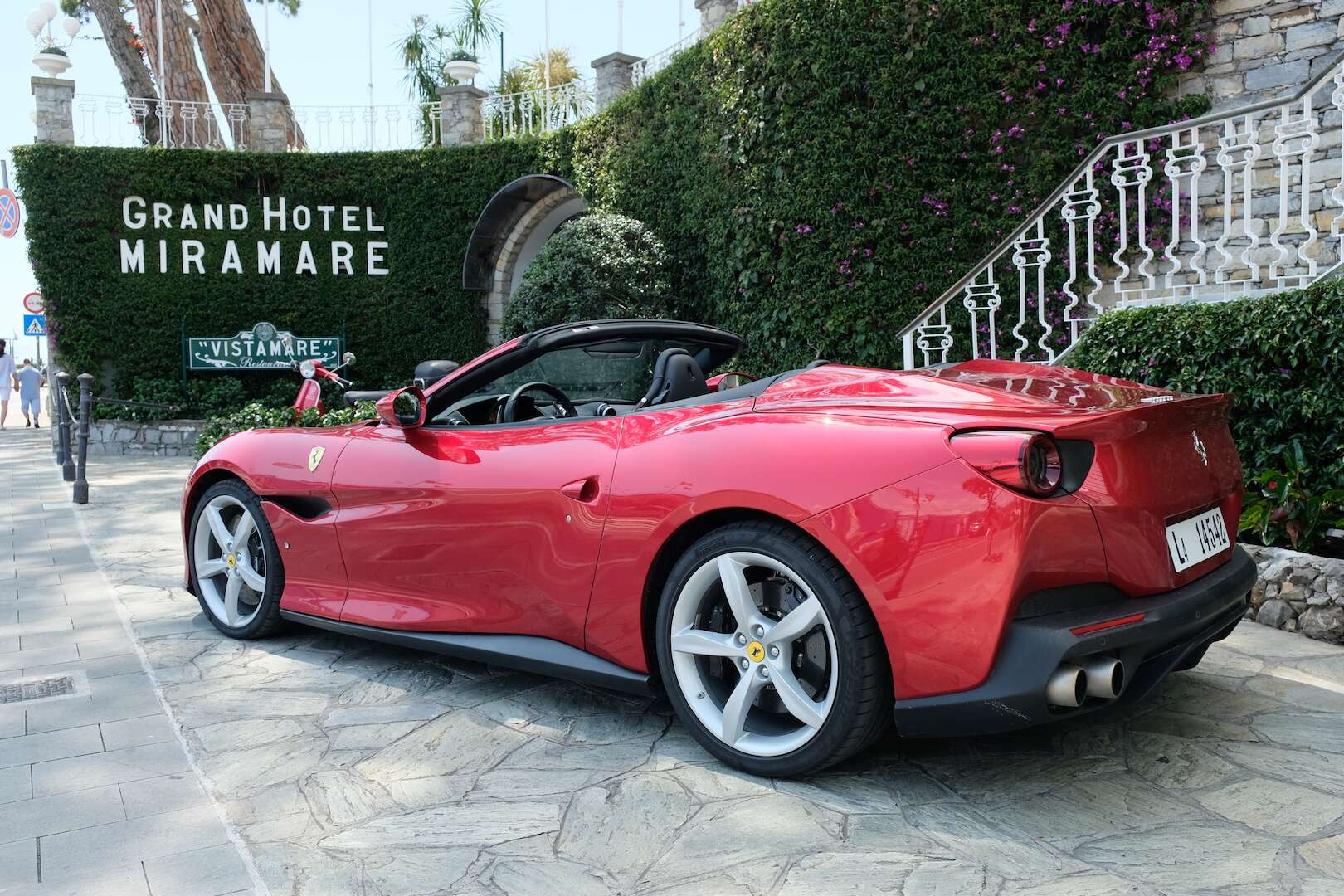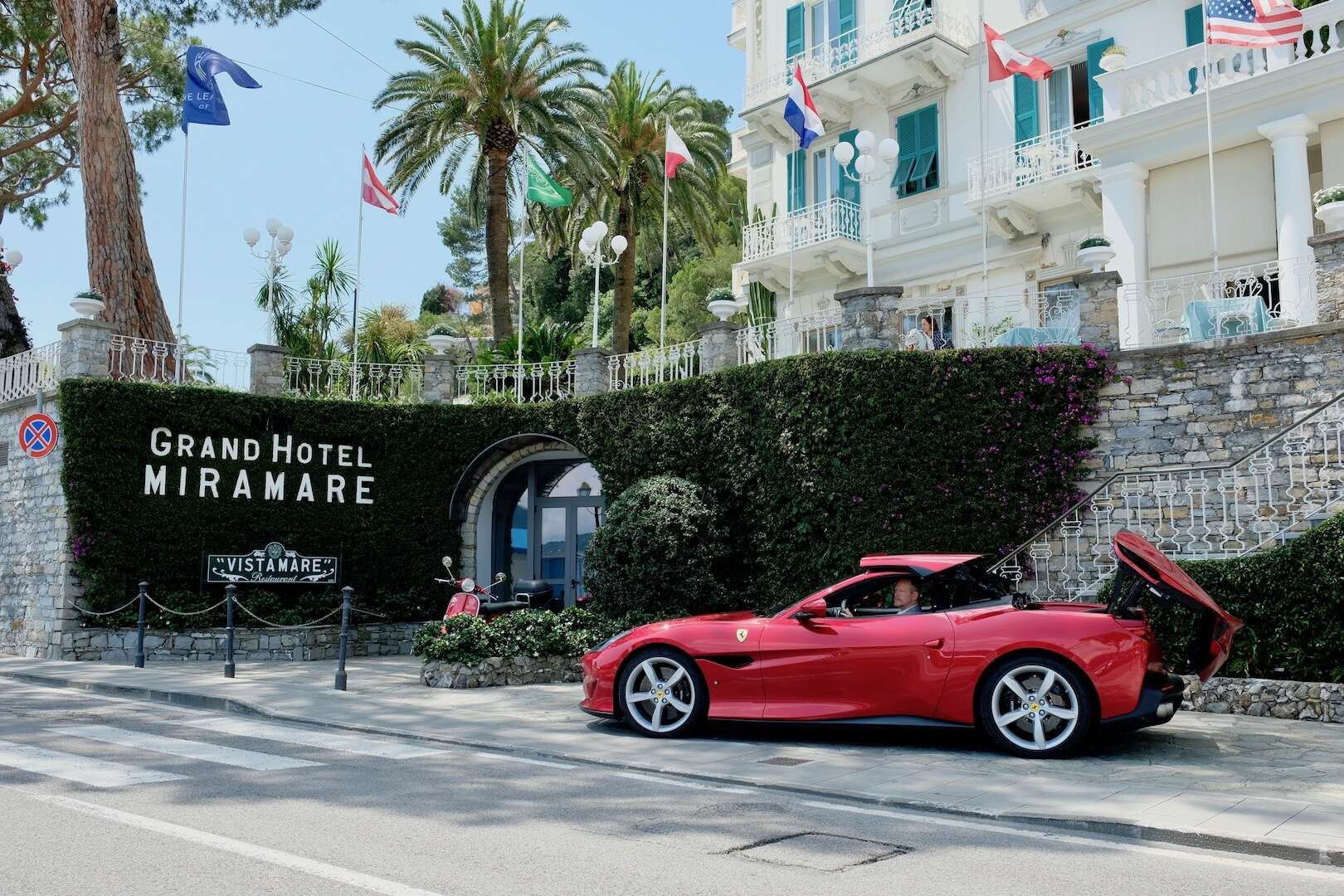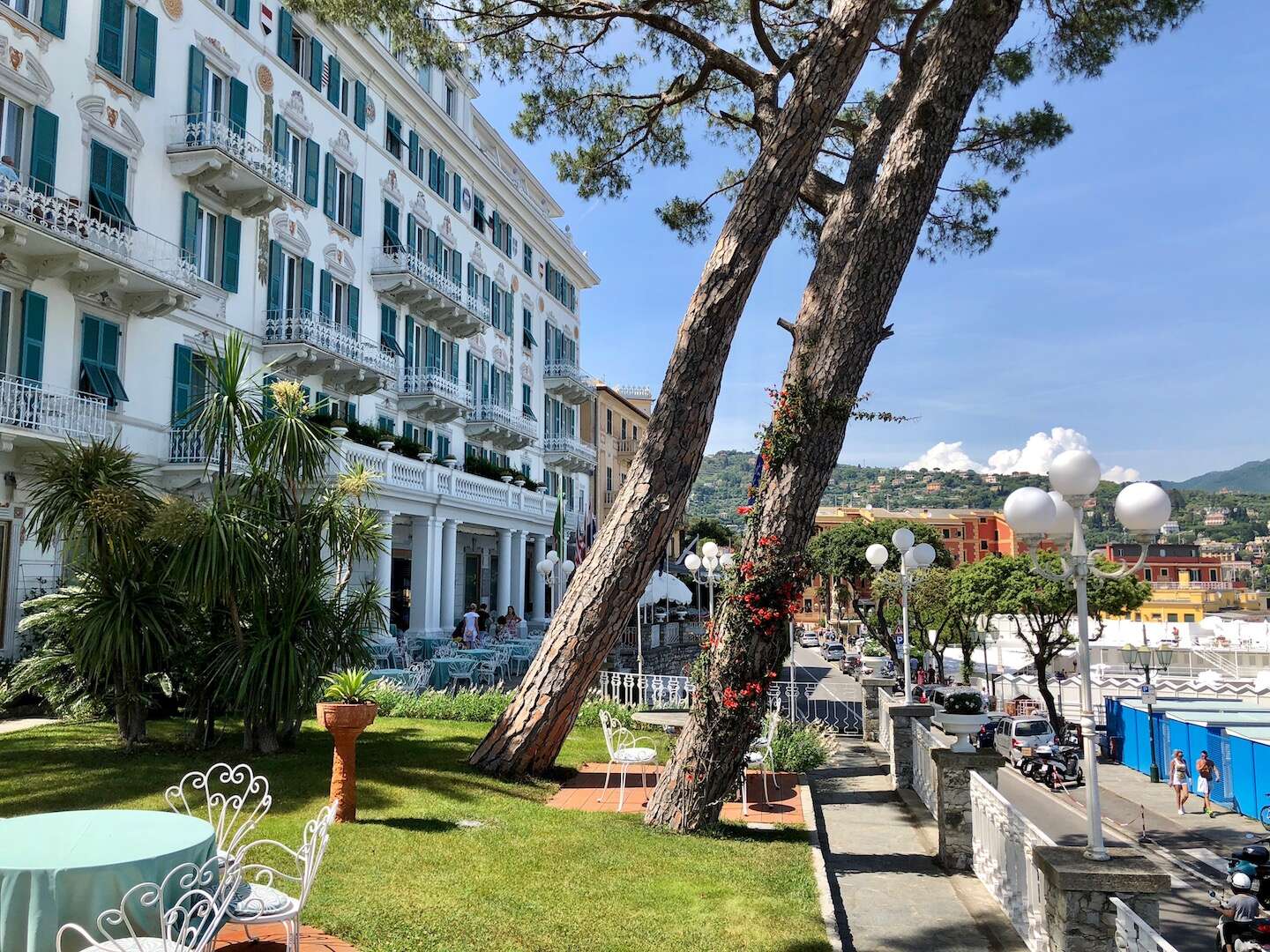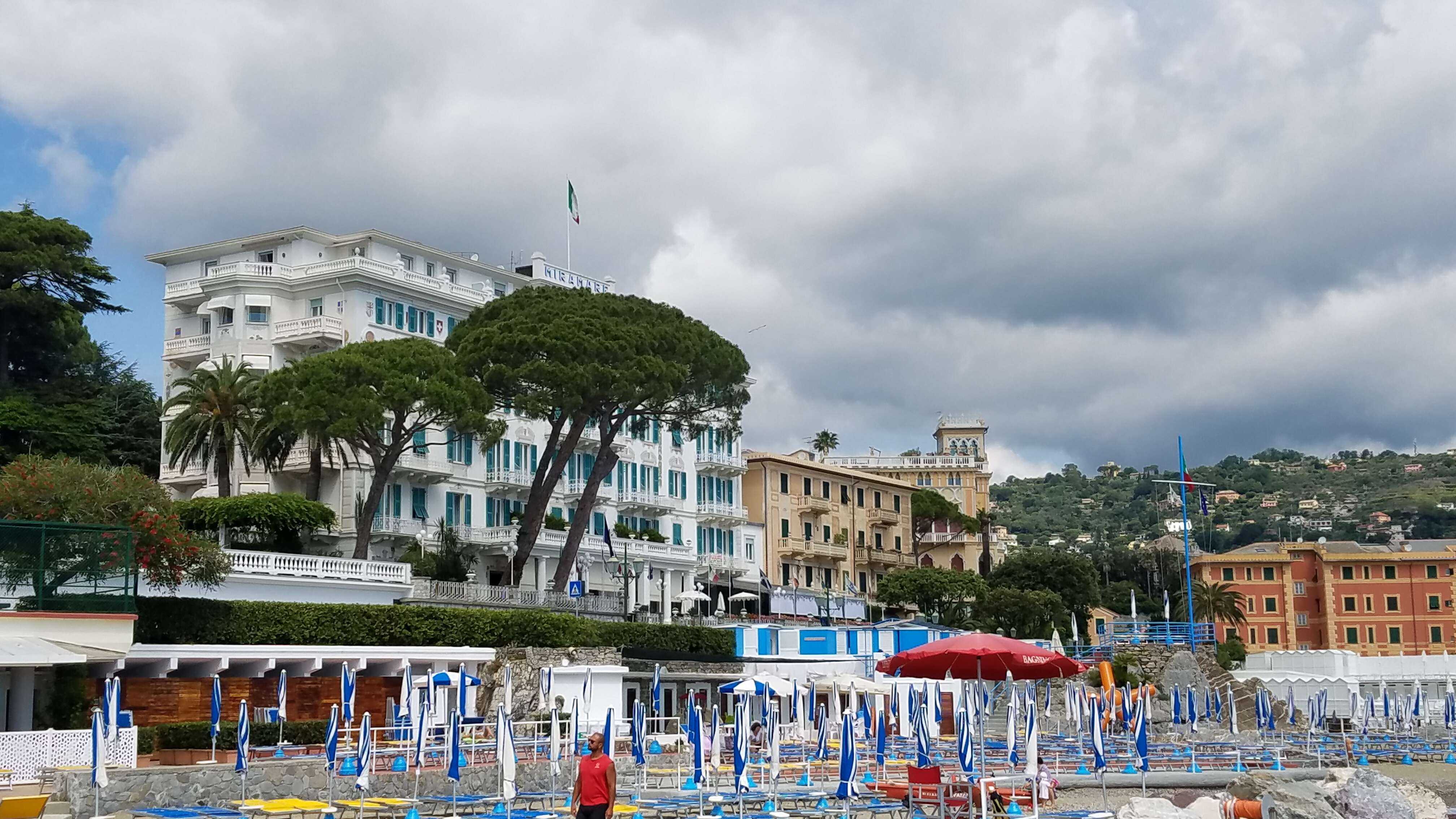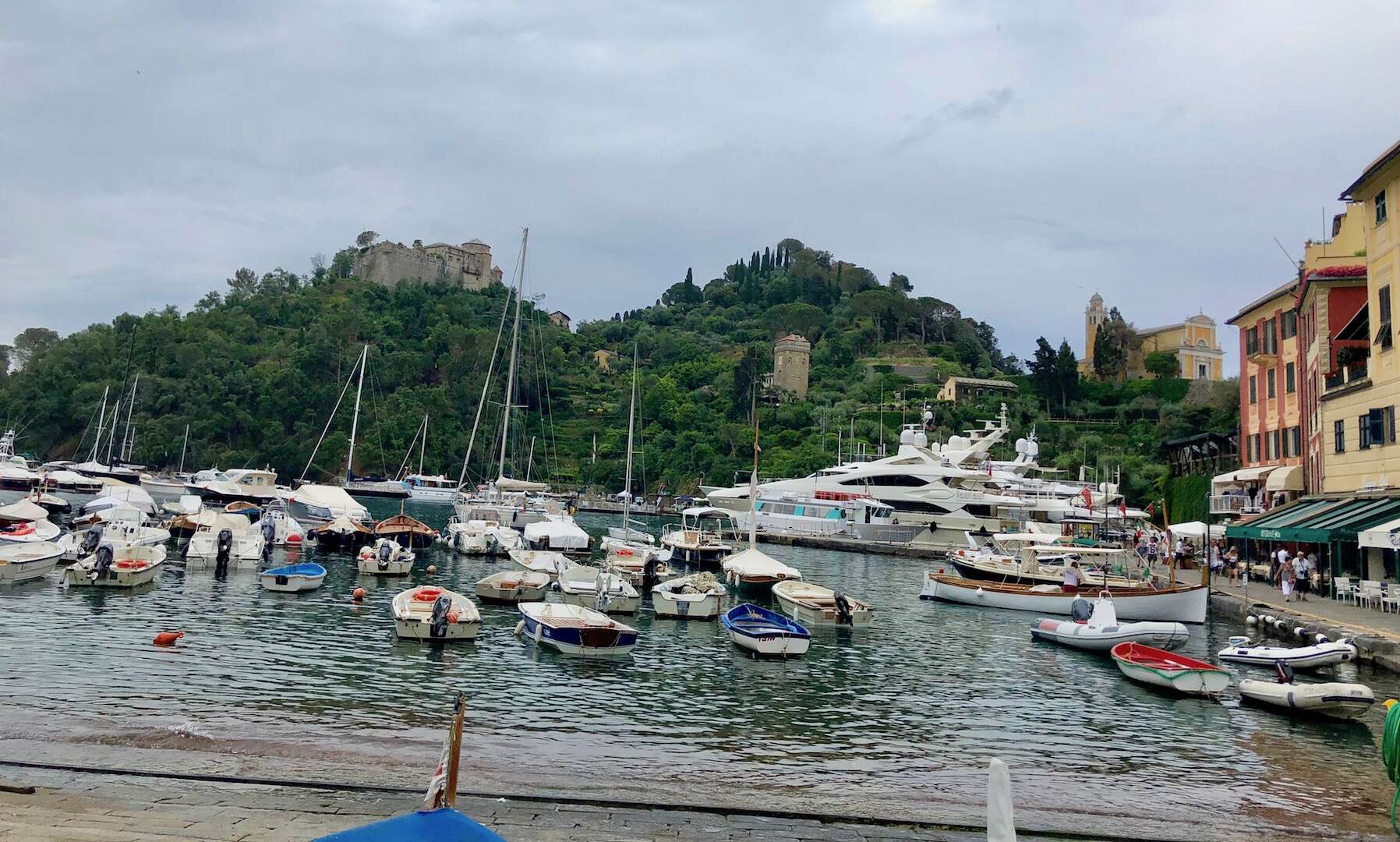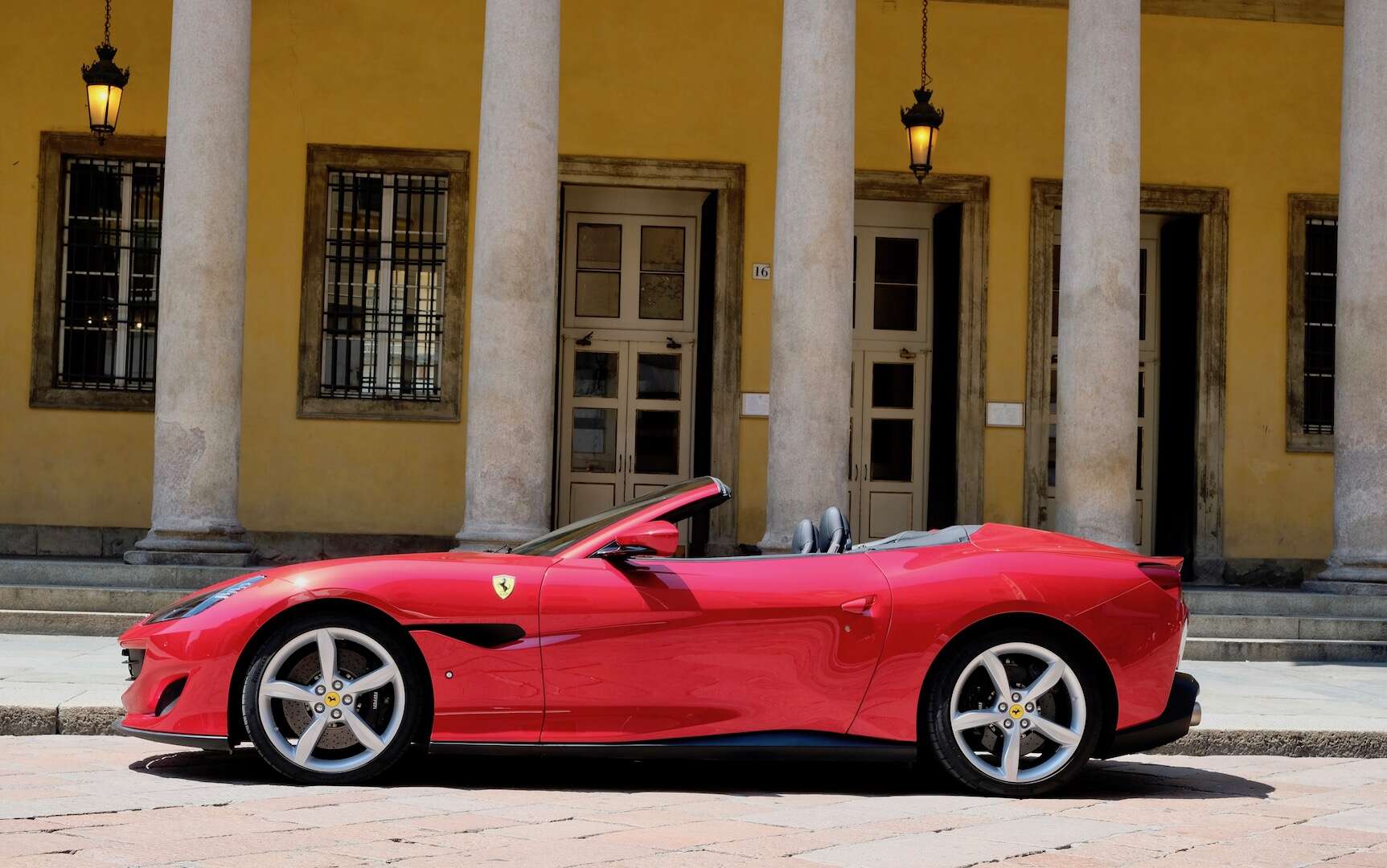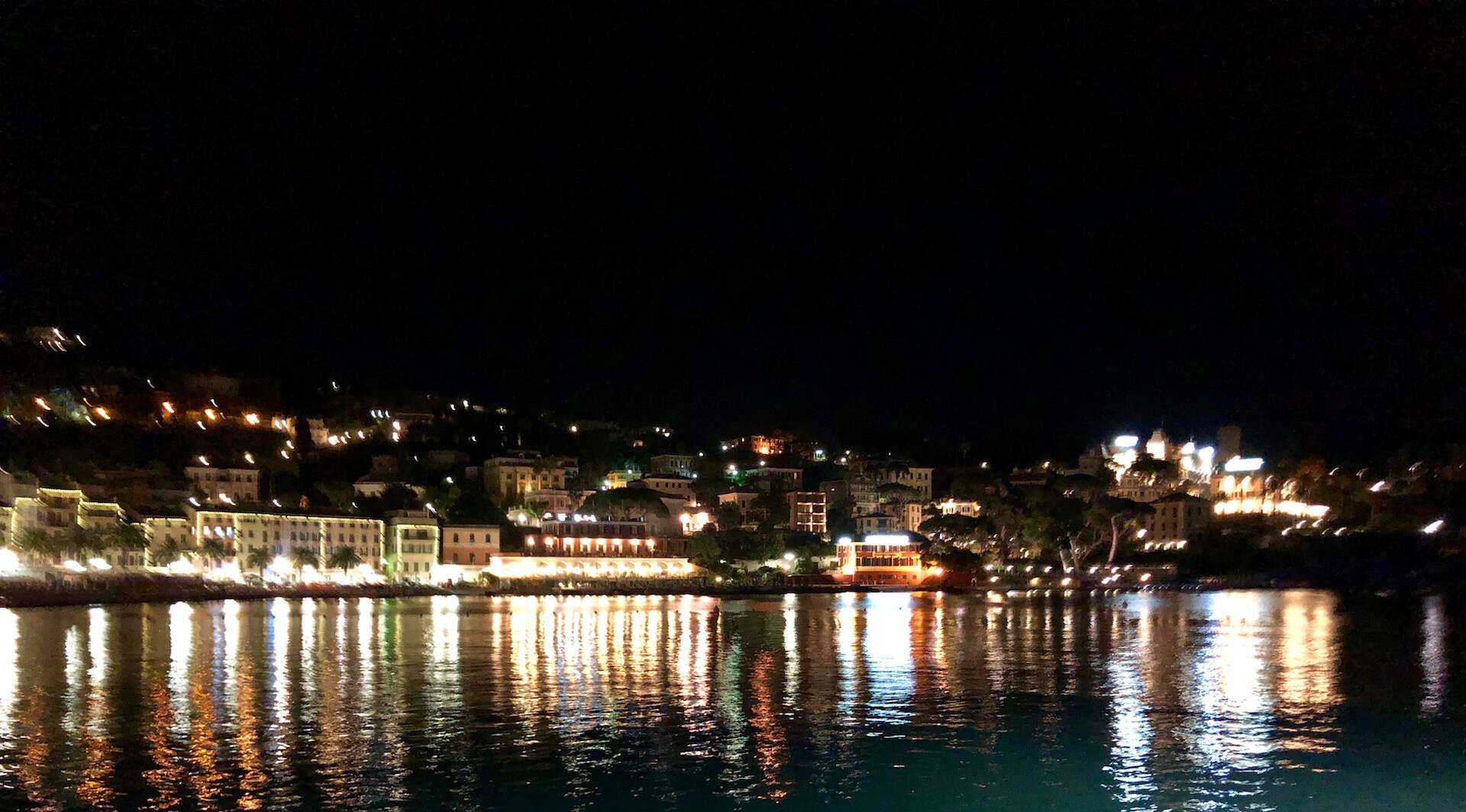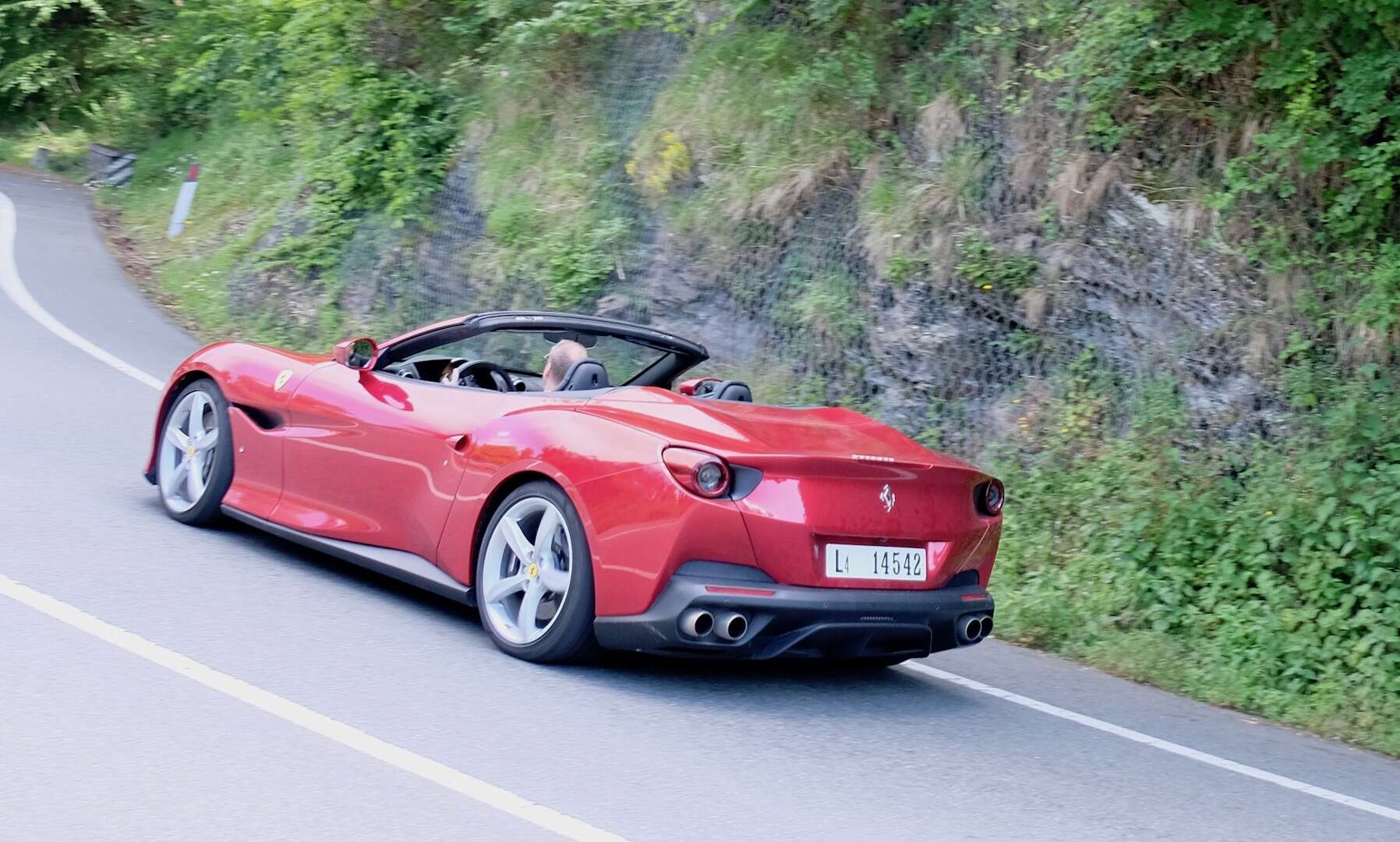Photographers like to say that the best camera is the one you have with you. That may go for Ferraris as well.
The Ferrari Portofino convertible is the markedly improved successor to the California and California T, the best-selling models in company history. And it’s the Ferrari that owners have with them most often. Between the Portofino’s generous cargo space and two-plus-two versatility, Ferrari says a remarkable 85 percent of owners will drive this car every day, versus just 35 percent for other Ferrari models. That practical reality hit me like our ton of luggage when my girlfriend Christine and I picked up the Ferrari at the company’s Maranello headquarters, in its signature color called Rosso Portofino, to kick off a road trip to, well, Portofino—along with other destinations on the Italian Riviera.
Ferrari cruises the hills outside of Cinque Terre
It occurred to me driving a Portofino in Portofino seemed a little on-the-nose, but Ferrari liked the idea enough to loan us the car. (It also beats driving a Chevy Malibu in Malibu.) We were eager to put the company’s daily-driving theories to the test, so we traveled heavy, stuffing luggage into the Portofino sitting just inside the company’s famous guardhouse gates as visitors craned their necks for an envious glimpse.
Ferrari convertible shines in signature Rosso Portofino paint
The clock was ticking on our return—I had to be back in five days for the Ferrari 488 Pista media launch at the company’s Fiorano circuit. And while the 591-hp, front-engine Portofino doesn’t match the maniacal thrills of its 710-hp, mid-engine cugino, it did prove a dual-purpose GT dream: It flowed like fine Barolo down the highway while letting us soak up the sun. Yet the Portofino can also stiffen its magnetic-ride shocks and dispatch curves like a serious sports car. All for $214,533 to start—a square deal by Ferrari standards.
That 488 Pista, at $345,000, would be frankly useless for a traveling couple that intends on changing clothes. The Pista has no back seat, no rear hatch, and not even a glovebox, only an underhood “frunk” that can manage a single carry-on-size bag. Even in the relatively roomy Portofino, I’d assumed that Christine’s huge roller-bag would have to perch upright in the back seats, which are roughly the size of a Porsche 911’s. Instead, the big-ass suitcase not only fit in the trunk, but squeezed below the divider that must be in place to lower the roof. No need to unload luggage at hotels before enjoying top-down motoring.
La Grassa, La Dotta, La Rossa
We spent our first day in Bologna, the scrappy, underrated Italian city that deserves a shout-out. True to one of its three nicknames—”La Grassa,” or “the Fat One”—Bologna is the capital of perhaps the nation’s most acclaimed food region: Emilia-Romagna, the breadbasket of Italy, whose world-famous staples include prosciutto di parma, Parmigiano-Reggiano cheese and the balsamic vinegars of Modena. To car and motorcycle fans, of course, Emilia-Romagna is also known as the Motor Valley, housing the factories of Ferrari, Maserati, Lamborghini, Ducati and upstart Pagani. Travelers making the pilgrimage will want to check out the Museo Enzo Ferrari in Modena, the birthplace of the company founder; the Museo Ferrari at the company headquarters and factory in Maranello; and the recently expanded Museo Lamborghini in Sant’Agata Bolognese.
Bologna is home to the one of the world’s oldest universities, operating continuously since 1088. That results in the nickname “La Dotta,” a.k.a “the learned one.” You want to compare alumni, frat boy? Dante, Petrarch, and Erasmus studied here, along with several popes.
We walked the medieval grid of a city whose sidewalks feature 25 miles of graceful arched colonnades, making sunscreen (or umbrellas) almost unnecessary. We gawked at the Due Torri, the two leaning towers of Asinelli and Garisenda; the latter boasting more tilt, at four degrees, than the more-famous tower in Pisa. Bologna’s final nickname, “La Rossa,” refers to the red terracotta brick that blankets the city’s rooftops, but more recently to its left-leaning history, from the anti-fascist resistance of World War II to today’s graffiti-spraying, protest-loving students. But after a day of walking, “red” had us thinking about bolognese, in the pasta form of tagliatelle al ragù. So it was off to Trattoria Anna Maria, where the titular, 78-year-old host has been kneading, pulling and cutting handmade egg pasta for 33 years. It’s a real nonna joint, as simple and authentic as it comes. The region’s classic dish, tortellini en brodo, may look like boring chicken soup, until you taste a bowlful like Anna Maria’s: Ring-shaped (or navel-shaped, as in “ombelico”) tortellini pasta, stuffed with minced-pork filling. The tortellini bob like golden life preservers in a sea of fresh chicken broth, awaiting a hungry rescuer.
The Road to the Riviera
We shot west from Maranello toward the Mediterranean’s Riviera di Levante, the strip of coast between the south of France and the border of Tuscany. In easy-going automatic mode, the Ferrari feels plush, happy to burble like a baritone Sinatra in the seventh gear of its dual-clutch automated gearbox. But this crooner can also call in a mob hit: Every squeeze of the throttle elicits a fierce Ferrari charge that reels in overmatched traffic ahead. The twin-turbo, 3.9-liter V-8 carries the Portofino to 60 mph in a claimed (and conservative) 3.4 seconds, to 124 mph in 10.8 seconds, and to a 199-mph peak. If this is a GT, it’s definitely a fast one.
Ferrari says this 8,000-rpm powerplant—which has won the International Engine of the Year award three years running—has faster throttle and turbo response than any forced-induction engine in the world, and I don’t doubt it. I’d also swear on the Pope’s bible that the V-8, with a turbo housing and exhaust manifold that are sand-cast (rather than bolted) directly into the cylinder head, sounds lustier than the same engine in the standard Ferrari 488. With the Portofino’s top down, it’s no contest.
An open-air amphitheater for the 591-hp, twin-turbo V-8
We pulled off for lunch in lovely riverside Parma, another city that tourist hordes tend to skip, making it a chill destination for discriminating travelers. The Ferrari burbled its way into the city center, where I hit the steering wheel’s “bumpy road” switch that butters up the ride over pocked streets. The medieval town is the birthplace of the Renaissance painter Correggio, and we popped into the 900-year-old cathedral whose interior duomo features his monumental frescoes. Parma also gives its name to aforementioned Parmesan cheese and Parma ham; it’s home to the big Barilla pasta company and the ALMA school, the nation’s top training institute for Italian cuisine. Hmm, I hope we can find something decent to eat.
That something turned out to be tigelle, (pronounced “ti-GEL-ay”), the mold-baked flatbread—often with a flower symbol molded in—that National Geographic aptly described as “the lovechild of a pancake and an English muffin.” We polished off tigelle rounds, filled with salumi and fillings—mortadella, prosciutto, fat-melting lardo—until we ourselves were full. Time to move on, quickly.
Cinque Terre: Cars Keep Out
After a brisk passage through the Apennine Mountains that span the length of Italy (and northern Sicily, too), a final ascent up the Ligurian coast brought us to Cinque Terre. Until the railway arrived around 1870, these five fairy-tale villages were only accessible by foot trails that farmers dug from the hillsides, one stone at a time. The lives of residents revolved entirely around the sea, and the insanely steep agricultural terraces—some nearly 1,000 years old and a mile long—that give grape vines and olive trees a tenuous place to cling.
A charming, cliff-carved oceanside railway connects the villages (and Italy beyond) along just eight miles of Ligurian coast, but bring your walking shoes. The easy-hiking Via dell’Amore, or Lover’s Walk, is still closed after a 2012 landslide that injured four Australians. But the 70 miles of ancient trails include the 365 stair steps from the sea to Corniglia, or the rugged, spectacular 7.5-mile Blue Path that connects the villages of Riomaggiore, Manarola, Corniglia, Vernazza, and Monterosso.
Manarola in Cinque Terre, as beautiful as it gets in Italy, or all of Europe
Pastel-painted structures are stacked and wedged into hillsides
Scary-steep farming terraces, some planted for more than 1,000 years
This environmentally-fragile UNESCO World Heritage Site, whose directors have recently threatened a cap on tourists, is also quite inhospitable to Ferraris. Cars are largely barred from the villages proper. We were forced to park in a tiny public lot and schlep our luggage downhill to the entrance of Manarola, perhaps the most picturesque of all the Cinque Terra hamlets. But cars wouldn’t work here anyways, unless they could climb medieval staircases and negotiate “streets” that are better described as high-walled passageways, some as narrow as a king bed.
Cars are largely forbidden in Cinque Terra, but the polizia make an exception for our Ferrari
The five secluded villages, with only 4,000 full-time residents, were once a destination for in-the-know travelers. Now, 2.5 million visitors arrive a year, including day-trippers from cruise ships. Vernazza, especially, is the one to avoid in high season, trampled by fanny-packing Americans in their finest Disney ensembles. Fortunately, by sundown, as on Italy’s Capri, the day-trippers almost all leave, bid back to their nightmare all-you-can-eat vessels.
In group tourism’s defense, the place is crazy beautiful. Its multi-story structures—in painted pastels of ocher, pink, sienna—seem the work of an ingenious child architect: Building blocks, or shoeboxes, all stacked, strewn, and perched on the death-edge of gravity. Cinque Terre has something in common with our Ferrari’s complex roof: both maximize space in layered, beautifully Italian fashion.
This monument to vertical engineering extends to wine production. The local output includes sea-tinged Vermentino and Albarola grapes that create the Cinque Terra D.O.C. appellation, and the honey-luscious dessert wine called Schiaccetra. On a vertigo-inducing Ferrari drive between villages, it occurred to us that settlers in the 11th and 12th century had to be crazy or desperate to even think about farming here. Those traits have clearly been passed down, like the pesto recipes for which the Liguria region is famed. The ancient farm terraces are so steep that owners—including many small family plots—are required to haul equipment and produce in-and-out by hand, or on crazy homemade conveyors that could only be called Wine Rollercoasters. (I never did find out what they’re called in Italian).
I’ve been to vineyards around the world, and I’ve never seen anything like them: Powered by lawn tractor engines, clamped to metal monorails, with makeshift driver’s chairs and metal cages or baskets for carrying grapes and gear, the coasters plunge up, down and through the vertiginous slopes. I was really hoping for a ride in one—I would have been happy to trade a ride in the Ferrari—but on this day, no farmers materialized.
Young children may squeeze in back, but the space is best left for luggage
This may be the land of pesto, but we honestly prefered the freshly-caught seafood. If you go, don’t miss Trattoria dal Billy (“from Billy”) in Manarola; specifically, its antipasto di mare, a roughly 12-dish “starter” course of deceptively homespun seafood specialties. Those include some of the best anchovies you’ll ever put in your mouth, fished from the Mediterranean on moonlit nights, then cleaned, packed in raw salt, and cured for roughly six months in wooden boxes called “arbanella.” As for the Schiaccetra, try Nessun Dorma, the cave-like cantina where local wine and good times flow. How tiny and intimate are these villages? Billy’s, the best restaurant in town, was about 30 paces from our rented apartment.
Ulrich in a rare moment of relaxation
On our last day in Cinque Terre, it occured to us that we didn’t have a single photo of the Portofino inside one of the villages. So I broke the rules and brazenly drove the Ferrari smack into Corniglia—or as far as I could before the streets narrowed too much to prevent forward progress. I hopped out to take a few shots—but it wasn’t easy, because the Portofino immediately drew a crowd of selfie-snapping tourists, locals, and finally, a pair of polizia. The cops didn’t even blink, or ask us what the hell we were doing there; they just oohed and aahed along with everyone else. Such is the power of Ferrari, especially on its home turf, where locals tend to treat any sighting like a visit from the Virgin Mary.
Vernazza and its cozy marina
Portofino and Santa Margherita Ligure: The Good Life
The Portofino made another entrance at its namesake resort town on the Italian Riviera. We sat in the Piazzetta, the cinematic flagstone square overlooking the tiny harbor, and gawked at the yachts docked nearby. From here, a steep path winds to Castello Brown, a 15th-century fortress and museum with spectacular views of Portofino and the Ligurian Sea. Another path leads over the promontory to one of the most ridiculously scenic beaches in all of Europe, its backdrop the medieval abbey of San Fruttuoso. This ain’t the Jersey Shore. (That said, the beach was featured in The Trip to Italy, the wryly hilarious travel doc with actors Steve Coogan and Rob Brydon).
Ferrari at home in chi-chi Santa Margherita Ligure
Portofino was a playground of the rich-and-famous in the Fifties and Sixties, and while that jet-set glamour has somewhat faded, the city and neighboring Santa Margherita Ligure are still awash in old-world charm and old-money villas—including homes owned by Giorgio Armani and Stefano Gabbana, or the castle notoriously rented for €675,000 by former prime minister Silvio Berlusconi. (Here’s what a modest $11 million will get you in a villa these days). Back in 1991, Portofino’s 650 full-time residents banned noise-polluting helicopters, because wealthy folks were using them to fetch morning newspapers from nearby Genoa in time for breakfast. And like a seaside, Italian version of Palm Springs, the area seems on the verge of a Rat Pack-style renaissance.
Portofino is a Transformer, Italian-style
The la dolce vita vibe is on full display at the Grand Hotel Miramare, where we stayed. Built in 1903, the elegant Liberty Style hotel (Italy’s version of Art Nouveau) is a frescoed, white-stucco wedding cake that has seen the ebb and flow of Italian Riviera history. Vivien Leigh and Laurence Olivier honeymooned at the Miramare in 1949. Richard Burton and Elizabeth Taylor also stayed—and, let’s assume, smoked, drank, and fought—here. The beachfront hotel’s owner, restorer, and champion is Andrea Fustinoni. His family made its money in Milan’s ice and refrigeration business in the early 20th Century as owners of Frigoferi Milanese, the now-restored warehouse complex that cooled the city’s meat and produce; and the Palazzo del Ghiaccio (or “Ice Palace”), the handsome skating and sports facility that was then Europe’s largest indoor skating rink. (Pink Floyd was among the musical acts that played there, in a 1971 concert). The Fustinoni family moved to the Riviera in the wake of World War II and acquired the Grand Hotel Miramare in 1945.
“People just wanted a vacation after such a long war,” Fustinoni said over breakfast on the Miramare’s shaded terrace.
Asked to describe the Italian Riviera, the elegant Fustinoni—who also served as longtime president of the national Italian Trust for the Liguria region, which promotes the arts, history and culture—summed it up thusly: “It’s a mix of glamour, old Hollywood atmosphere, shabby chic and Mediterranean food,” he said with a smile. Oh, and the smell of flowers—specifically pitosforo, whose fragrant white blossoms burst from perfectly-manicured shrubs and hedges.
The Grand Hotel Miramare, built in 1903, is being lovingly restored
We dug into that Mediterranean food at Du Coq, whose intimate garden serves up a hybrid of the French and Italian Rivieras: Towering seafood plateaus loaded with prized Belon oysters from Brittany; crab, sea urchin, whelks, winkles, whatever. The Ferrari seems born for top-down cruising along the city’s lungomare, or beachfront promenade. For one, it’s much prettier than the old California, including a gigolo grin that’s straight from the V-12-powered 599 GTB and 812 Superfast models. That body is beach-toned as well, carrying 175 fewer pounds than the California, including such weight-savers as an aluminum underbody and magnesium seat frames.
If only the Ferrari were skinnier: In this wide-bodied sports car, the drive into Portofino proper was a white-knuckle challenge that made Italy’s notorious Amalfi Coast seem like child’s play. The only way in is roughly five miles of needle-threading curves, on a road that seems to have been engineered by drunken Roman soldiers. (It probably was). If you can’t find a parking space in a single public lot near Portofino’s town hall, you’re forced to turn around and drive the entire way back. When we first reached that underground lot, the down ramp was blocked by a Nissan van stuck between its curving, impossibly-narrow walls. Gulp.
Yacht Rock: The harbor at Portofino
We split out of Portofino when the rain began to fall…and then a tour bus loomed into view on a blind hairpin, causing Christine to yelp involuntarily as I nailed the powerful brakes. The bus driver held his palms up, the universal, “Whaddaya want me to do?” gesture. I was forced to back up and scrunch up against the seaside wall, folding the Ferrari’s mirrors to clear the gap. The diesel-huffing bus found just enough margin to crawl past, with maybe two inches to spare. The bus passengers pressed against the windows to snap photos of the Ferrari’s ordeal, and our own stricken faces. Pro tip: If you’ve rented a scooter, or a Fiat 500, you might consider driving into Portofino proper. If not, you’re better off on that bus, or on ferries that shuttle you from Rapallo, Santa Margherita Ligure, and other cities.
After all that, driving the Ferrari in monsoon rain to a Gucci outlet—and then a Gucci store up the coast in Genoa—was pure relaxation. (Christine had her heart set on a specific handbag at a steep, value added tax-free discount). That I also find a €2,000 blazer marked down to €200 was entirely secondary: I’d earned major boyfriend points. Christine herself commented on the unspeakable bougie-ness of going Gucci shopping in a Ferrari in Italy. I suggest we keep the whole pathetic excursion to ourselves. But then I had a great idea: A “Hater’s Gallery,” of travel photos for readers who thought they were clicking on a Ferrari review, only to read about Italian cuisine, architecture, history and destinations. So, behold:
The Hater’s Gallery
And now, back to the nuts-and-bolts of automobiles. When that rain started pelting, we didn’t even have to pull over: The Portofino’s metal top—whose roofline now curls into rear flanks in a voluptuous imitation of a traditional Ferrari berlinetta coupe—opens or closes at speeds up to 25 mph. Christine, who’d been riding shotgun the whole way, adores the car but ends up unimpressed with the feature designed expressly for her: the secondary, 8.8-inch touchscreen (also found in the GTC4 Lusso and 812 Superfast) that lets passengers monitor functions, or control some of their own, such as adding a detour to an existing nav destination. The screen does look cool, but after the first few hours, you realize it’s largely a novelty that will mostly gather dust. First, the passenger’s controls are limited and somewhat clumsy. Second, how many shotgun riders want to stare at a tach or the performance settings? And not to mention, there are some drivers (ahem) who don’t necessarily want their passenger knowing exactly how fast they’re going. Fortunately, the Portofino also boasts the excellent 10.3-inch central infotainment screen and dual TFT driver’s displays flanking the tach, setups that have yanked Ferrari into the modern age of useful infotainment.
Blue Mediterranean, Santa Margherita Ligure
The fine seaside weather reappeared the next day, but it was time to zip back to Ferrari HQ in Maranello and trade the Portofino for the 488 Pista. The fastest route: the A15 Autostrada, or the Autocaminiola della Cisa, which crosses the Cisa mountain pass at the border of Tuscany and Emilia-Romagna. The A15 from La Spezia to Parma is one of those European-engineered marvels that makes American freeways look like a decaying tapeworm inside a diseased host. Tunnel after tunnel bore through the mountainsides, so many that we lost count. They’re so perfectly lit and laid, I stormed through their long, curling passages at triple-digit speeds while suppressing a yawn.
Yet it can be a super-challenging road, so much so that manufacturers use it to test heavy-duty trucks: Those tunnels open onto huge elevated sections, along with multi-mile ascents and descents like a video-game fantasy. 40, 50, 60 turns came at us consecutively as we descended down into valleys and up again, each curve a chance to dial the Ferrari’s telepathically precise steering, then romp away from traffic with a snarl and surge from the V-8. The Portofino’s magnetic suspension is tuned to be a bit yielding, so there’s more body roll than in the 488 or 488 Pista, even with the steering-wheel manettino switch dialed to its racier settings. And compared with any 488, the Portofino’s handling is more tentative at blinding speeds, including only modest feedback transmitted through the wheel, but I learn to trust the grip. Here, and throughout our journey, the incredible lane discipline of European drivers is a key: I was careful to not overtake too quickly, but America’s oblivious left-lane campers and cut-off kings—the ones that ruin so many potentially great highway drives—simply don’t exist here. If you want to drive all day at 100 mph—or 150 mph—a potential speeding ticket is the only thing standing in your way.
Made in Italy, made for road trips
We descended into the sun-baked Po Valley, and pumped more than €100 of premium fuel into the thirsty Portofino. The next day, I’d be driving the Pista at the Fiorano track, while Christine opted for a balsamic vinegar tour at a Modenese farm. As noted, that 488 Pista is a relative freak show in terms of performance. But it’s no vacation in terms of useable space, a livable long-distance ride, or the ability to drop a top and admire Italy in all its splendor. For that Ferrari vacation, it’s the Portofino all the way.
Lawrence Ulrich, The Drive’s chief auto critic, is an award-winning auto journalist and former chief auto critic for The New York Times and Detroit Free Press. The Detroit native and Brooklyn gentrifier owns a troubled ’93 Mazda RX-7 R1, but may want to give it a good home. Email him at [email protected]
Source: Read Full Article

